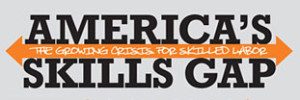 There’s been a consistent buzz about the problem of the U.S. Labor force’s skills gap. Every week there seems to be a discussion on what’s causing the gap and how it can be addressed. In a recent Fortune Magazine article by Joseph Fuller, Senior Lecturer in General Management at the Harvard Business School, he talks about the eroding “skills base of the American workforce,” and it’s “threat to U.S. competitiveness.” The absence of skills for the “middle skill jobs” is particularly concerning. What exactly does Fuller mean when he speaks of “middle skills jobs?’ He’s referring to those jobs that require training beyond high school, but less than a four-year degree. These are jobs that require specialized training or certifications and, sometimes, two-year Associates Degrees.
There’s been a consistent buzz about the problem of the U.S. Labor force’s skills gap. Every week there seems to be a discussion on what’s causing the gap and how it can be addressed. In a recent Fortune Magazine article by Joseph Fuller, Senior Lecturer in General Management at the Harvard Business School, he talks about the eroding “skills base of the American workforce,” and it’s “threat to U.S. competitiveness.” The absence of skills for the “middle skill jobs” is particularly concerning. What exactly does Fuller mean when he speaks of “middle skills jobs?’ He’s referring to those jobs that require training beyond high school, but less than a four-year degree. These are jobs that require specialized training or certifications and, sometimes, two-year Associates Degrees.
An April 2015 study by Brookings Institute visiting fellow Harry Holzer discusses the growth of middle skills categories in Healthcare, Construction, Installation/Maintenance/Repair, Managerial (low-end), and Services (high-end). Holzer draws the conclusion that this skill set, which requires more postsecondary education and training, is experiencing consistent growth.
This skills gap has been profoundly felt in Louisiana. The phenomenal economic expansion we are experiencing has created a need for “middle skilled” workers in high-demand, high-wage industries such as welding, pipefitting technology, electrical, advanced manufacturing, petroleum technology and process technology.
What to do about this skills gap? Fuller thinks, “employers should take the lead.” He talks about the need for business to develop an understanding of just how critical the supply of skilled labor is on their competitiveness. Instead of thinking in the short term and poaching talent from one another they need to cultivate talent pipelines to ensure continued growth for the long haul.
Fuller also suggests that educators be more realistic in their curriculums, particularly for those “students who will seek jobs outside of academia.” The Jindal administration has taken positive steps to work with educators to close this middle skills gap by their creation of the WISE Fund, passed by the Louisiana legislature in 2014. This law has provided funding to public colleges, including the Louisiana Community and Technical College Schools, to target specific workforce needs.
Finally, “policymakers need to…foster an environment in which the marketplace for skilled workers clears more efficiently.” They need to encourage “better communications between employers and educators” and provide “better information on resources in the job market.”
There is much work to be done on this middle skills gap problem. Employers, educators, and policymakers are going to have to work hard, and creatively, to close this gap. And we’d better get busy now, because there are other countries in this world who are way ahead of us on this issue!
 Sources:
Sources:
https://fortune.com/2015/03/05/how-corporate-america-can-close-the-skills-gap/
https://www.brookings.edu/~/media/research/files/papers/2015/04/workforce-policy-briefs-holzer/polarization_jobs_policy_holzer.pdf
https://www.lctcs.edu/news-media/press-releases/governor-jindal-jpmorgan-chase-co.-announce-1-million-investment-to-fund-wo




 Site by
Site by